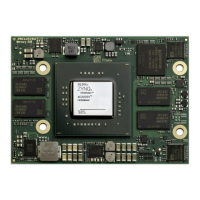Warning!
Special care must be taken when connecting the QSPI flash signals on the base board. Long traces or
high capacitance may disturb the data communication between the MPSoC and the flash device.
2.17.3 Configuration
The QSPI flash supports up to 50 MHz operation for standard read. For fast, dual and quad read speed
values, please refer to the flash device datasheet.
Note that the “Feedback Clk” option on pin MIO6 must be enabled in the Zynq configuration for clock rates
higher than 40 MHz.
Please refer to Zynq UltraScale+ MPSoC Technical Reference Manual [18] for details on booting from the
QSPI flash.
2.17.4 QSPI Flash Corruption Risk
There have been cases in which it was observed that the content of the flash device got corrupted. Ac-
cording to Cypress, this issue is caused by power loss during the Write Register (WRR) command. The most
common reason to use the WRR command is to turn the QUAD bit ON or OFF - this operation takes place
usually at the beginning of the boot process. If required, the bootloader code can be adjusted to set the
QUAD bit to a fixed value, without invoking this command during boot.
For additional information on this issue, please refer to the Cypress documentation and forum discussions
[24], [25].
2.18 eMMC Flash
The eMMC flash can be used to boot the PS, and to store the FPGA bitstream, ARM application code and
other user data.
2.18.1 eMMC Flash Type
Table 29 describes the memory availability and configuration on the Mercury+ XU8 SoC module.
Flash Type Size Manufacturer
H26M52208FPRI 16 GB SK Hynix
EMMC16G-W525-X01U 16 GB Kingston
EMMC16G-IB29-PZ90 16 GB Kingston
Table 29: eMMC Flash Type
Warning!
Other flash memory devices may be equipped in future revisions of the Mercury+ XU8 SoC module.
Please check the user manual regularly for updates.
D-0000-454-001 38 / 60 Version 06, 18.11.2019

